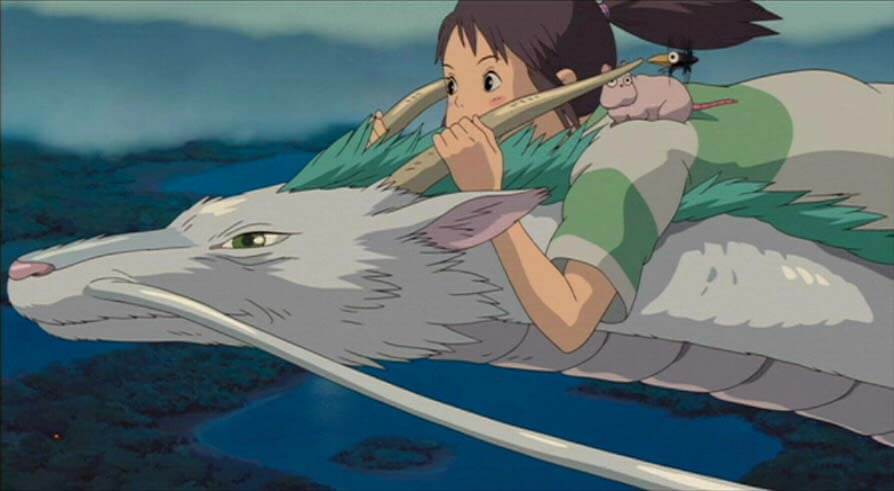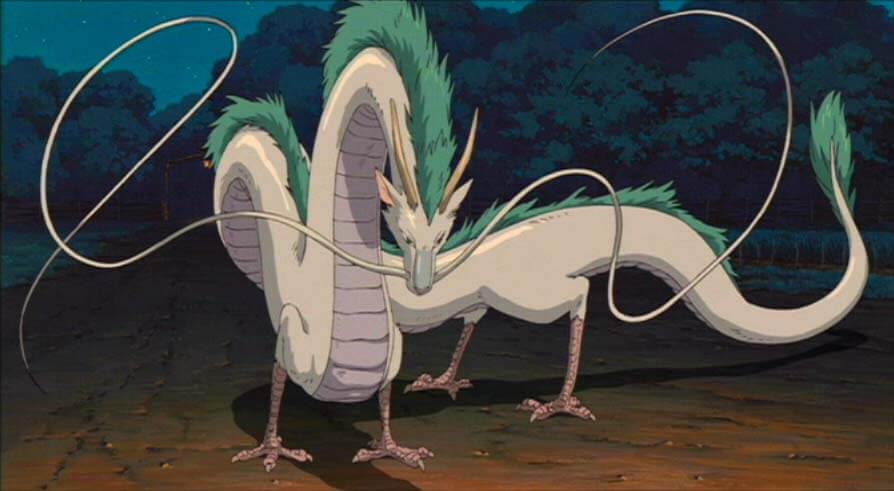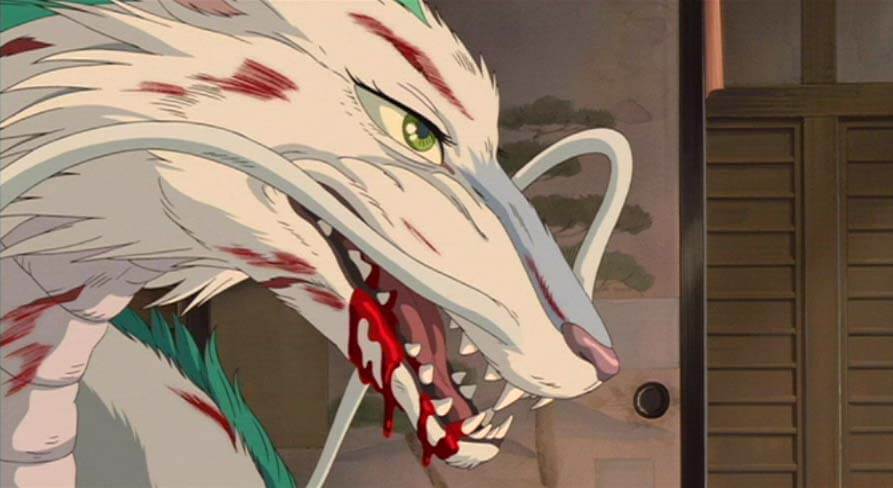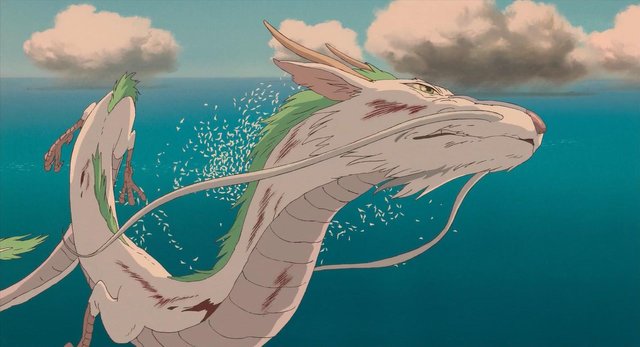When you think of Japanese pop culture, what’s the first dragon that comes to mind? If you answered Godzilla, you’re in for a heated debate. Although I would consider Godzilla a type of dragon (giant reptile, comes from the sea, emits power from the mouth…) most people consider him a general monster (kaiju) rather than a dragon. He’s got sci fi origins and doesn’t have the characteristics of a Japanese dragon, so we’ll set this kaiju aside in his science fiction world and get back to our mythical dragons.
Godzilla is out of the running? Most people I know will say Haku next. Or, if they don’t remember his name, they’ll say “the dragon from Spirited Away.” Now we’re talking. Just look at him. A beautiful example of a Japanese dragon.

For those of you not up on Hayao Miyazaki and Studio Ghibli, Spirited Away was an amazing animated film released in 2001. (Was it really that long ago!?!) It became the most successful film in Japanese history, grossing over $347 million worldwide and won the award for Best Animated Feature at the 75th Academy Awards, making it the first hand-drawn and non-English-language animated film to do so. In 2016, it was voted the fourth-best film of the 21st century as picked by 177 film critics from around the world, making it the highest-ranking animated film on the list.
In other words, it’s a great film. If you haven’t seen it, you should, and if you have seen it but don’t remember Haku’s name, it’s definitely time to watch it again. To recap, it follows a young girl, Chihiro (aka Sen) as she is whisked off to the spirit world where she meets a mysterious boy named Haku and works in a bath house.
Spoiler, Haku is really a dragon with the full name Nigihayami Kohakunushi, which means “god of the swift amber river.”
With all that out of the way, let’s dive into the dragony goodness of Haku.
Appearance

Haku is a great example of a Japanese dragon. At first glance, it can be hard to differentiate between Chinese, Korean, and Japanese dragons. But they all have slight differences. For example, Japanese dragons always have three toes instead of the four or five of other Asian countries. Haku might be problematic in that he has three large toes and a smaller one facing back, but I’ve definitely seen other Japanese dragons with similar talons. Talons? Claws? Feet?
This brings me to my next point, that Japanese dragons, like dragons in many other cultures, are depicted as a conglomeration of several different animals, usually the head of a camel, eyes of a rabbit, horns of a deer, scales of a carp, body of a snake, paws of a tiger, and claws of an eagle. Haku was also constructed from many different animals, down to his animation style. Miyazaki had his animation team draw inspiration from animals. When explaining the scene in which an injured Haku falls into the boiler room, Miyazaki used familiar animals to describe the action: the dragon clings to the wall like a gecko, before falling to the ground like a snake. When Chihiro fed Haku medicine, Miyazaki asked the animators to use a dog’s mouth as a model. No one on the team had a dog, so they went to a veterinarian’s office with a camera.
Finally, Japanese dragons tend to be thinner than their Chinese counterparts. Haku is a long, lithe dragon, putting him firmly as Japanese.
Demeanor

Japanese dragons can be moody. As opposed to Chinese dragons, which are considered auspicious, Japanese dragons are more like Hawaiian dragons — sometimes quite helpful, sometimes out to hurt humanity.
The thing about Japanese mythology is that its stories tend to center a human protagonist. While other cultures may tell the story of a dragon, Japanese myths usually tell the story of a person, using the dragon as a force to overcome. While dragons can bring positive things such as much-needed rain during a drought or protect people, they can also be mean and dangerous.
Haku shows this dual potential perfectly. He is often kindhearted and supportive with Chihiro, but sometimes he turns strict and high-strung. Throughout his mood swings, he remains wise, and mostly able to act accordingly to the situation. He also has the formal presence of a deity, which Japanese dragons often show. Basically, Haku is wild and powerful, not a being to be tamed nor fully trusted.
Haku and Nature

Haku was originally the spirit of the Kohaku River. However, when the river was drained and paved over, he lost his home, went to the spirit world, and lost his identity. This weakens him and allows Yubaba to control him. Near the end of the movie, Chihiro recalls falling into the Kohaku River and being saved by a dragon when she was younger. She realizes that Haku’s real name must be Kohaku, which frees him from Yubaba’s spell.
This brings us to a common theme in much of Miyazaki’s work: the delicate but important connection between man and nature. In Spirited Away, Haku the human wears the clothes of a Shinto priest, showing the importance of the Shinto religion in modern Japan. This, and his dragon form, makes him a call for humanity to remember and respect culture and nature.
When Chihiro is in a genuine, authentic relation with the Kohaku river, both she and Haku come to know their true identity, which is not two separate identities of individuals, but the identity of an authentic relationship. Only when she remembers the power of nature, represented by the dragon, do either of them remember their real names.
Not the Only Dragon

Haku isn’t the only dragon in Spirited Away. There is a short scene with a stink spirit, which is actually the kami of a badly polluted river. Chihiro helps clean the spirit by pulling out all sorts of trash, including a bicycle. This scene was actually inspired by Miyazaki’s personal experience pulling a bicycle out of a river during a community clean-up.
Only after the trash is removed, is the spirit recognizable as a pure, white dragon. This shows us yet again that we can only see nature for what it is when we respect and care for it.
So often dragons are represented as powerful beings that can destroy humans with a puff of breath or flick of the tail. But it’s important to remember that they can also be delicate and fragile. That they — and all they represent — need the care of humanity. I think that’s the takeaway from Haku in Spirited Away. Well, and that Japanese dragons are beautiful.
Sources:
https://digitalcommons.unomaha.edu/cgi/viewcontent.cgi?article=1673&context=jrf

Koji A. Dae
Koji is a dreamer, a mother, and a writer in that order. The first short story she clearly remembers writing involved fairies losing their wings, and ever since then mythology has found different ways to creep into her storytelling.

Be First to Comment